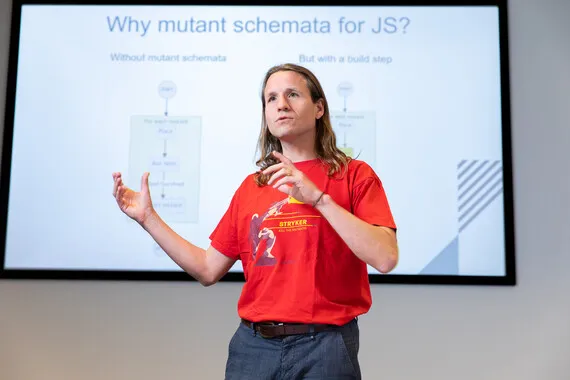course
Running Containers on Amazon Elastic Kubernetes Service (Amazon EKS)
Learn container management and orchestration for Kubernetes using Amazon EKS

Description
Amazon EKS makes it easy for you to run Kubernetes on AWS without needing to install, operate, and maintain your own Kubernetes control plane. In this course, you will learn container management and orchestration for Kubernetes using Amazon EKS.
You will build an Amazon EKS cluster, configure the environment, deploy the cluster, and then add applications to your cluster. You will manage container images using Amazon Elastic Container Registry (ECR) and learn how to automate application deployment. You will deploy applications using CI/CD tools. You will learn how to monitor and scale your environment by using metrics, logging, tracing, and horizontal/vertical scaling. You will learn how to design and manage a large container environment by designing for efficiency, cost, and resiliency. You will configure AWS networking services to support the cluster and learn how to secure your Amazon EKS environment.
This course includes instructor lecture, presentations, hands-on labs, demonstrations, and group exercises/discussions.
Who should attend This course is intended for:
- Those who will provide container orchestration management in the AWS Cloud including:
- DevOps engineers
- Systems administrators
Course Objectives In this course, you will learn to:
- Review and examine containers, Kubernetes, and Amazon EKS fundamentals and the impact of containers on workflows.
- Build an Amazon EKS cluster by selecting the correct compute resources to support worker nodes.
- Secure your environment with AWS Identity and Access Management (IAM) authentication by creating an Amazon EKS service role for your cluster
- Deploy an application on the cluster. Publish container images to ECR and secure access via IAM policy.
- Automate and deploy applications, examine automation tools and pipelines. Create a GitOps pipeline using WeaveFlux.
- Collect monitoring data through metrics, logs, tracing with AWS X-Ray and identify metrics for performance tuning. Review scenarios where bottlenecks require the best scaling approach using horizontal or vertical scaling.
- Assess the tradeoffs between efficiency, resiliency, and cost and impact for tuning one over the other. Describe and outline a holistic, iterative approach to optimizing your environment. Design for cost, efficiency, and resiliency.
- Configure the AWS networking services to support the cluster. Describe how EKS/Amazon Virtual Private Cloud (VPC) functions and simplifies inter-node communications. Describe the function of VPC Container Network Interface (CNI). Review the benefits of a service mesh.
- Upgrade your Kubernetes, Amazon EKS, and third party tools.
This course is provided by and at the location of a partner of Info Support; any discount arrangement with Info Support does not apply here.
When you register with an Info Support Master Key Card, extra days will be charged. Contact Info Support for more information.
Prior Knowledge
- Completed Amazon Elastic Kubernetes Service (EKS) Primer
- Completed AWS Cloud Practitioner Essentials (CP-ESS) (or equivalent real-world experience)
- Basic Linux administration experience
- Basic network administration experience
- Basic knowledge of containers and microservices
Subjects
Day 1
Module 0: Course Introduction Course preparation activities and agenda
Module 1: Container Fundamentals Design principles for building applications What are containers? Components of a container Writing Dockerfiles
Module 2: Kubernetes Fundamentals Challenges of managing many containers What is Kubernetes, and why is it important? Components of the Kubernetes control plane Kubernetes worker nodes and pods Key Kubernetes objects Managing Kubernetes with kubectl Hands-On Lab 1: Deploying Kubernetes Pods
Module 3: Amazon EKS Fundamentals How Amazon EKS manages the Kubernetes control plane Fundamentals of Amazon EKS security Use cases for extending Amazon EKS to the data plane Running worker nodes on managed node groups Running containers on AWS Fargate with Amazon EKS Amazon EKS tasks versus Kubernetes tasks
Module 4: Building an Amazon EKS Cluster Visual review of the Amazon EKS architecture to be built in labs IAM authentication Amazon VPC and AWS networking fundamentals Different methods to create a cluster High-level steps in cluster creation Function of eksctl Preparing for labs: Review the lab activities for the course Hands-On Lab 02: Building an Amazon EKS cluster
Day 2
Module 5: Deploying Applications to Your Amazon EKS Cluster Publishing container images to Amazon ECR Deploying applications with Helm Continuous deployment in Amazon EKS GitOps and Amazon EKS Hands-On Lab 03: Deploying applications
Module 6: Architecting on Amazon EKS Part 1: Observe and Optimize Configuring observability in an Amazon EKS cluster Collecting metrics Using metrics to automatically scale EC2 Auto Scaling groups Managing logs Application tracing in Amazon EKS Gaining and applying insight from observability Hands-On Lab 04: Monitoring Amazon EKS
Module 7: Architecting on Amazon EKS Part 2: Balancing Efficiency, Resiliency, and Cost Optimizing your Amazon EKS application architecture Relationship between cost, efficiency, and resilience Anatomy of an Amazon EKS cluster from a cost perspective Using tagging with pod placement for cost accountability Sizing containers and worker nodes efficiently
Day 3
Module 8: Managing Networking in Amazon EKS Review: VPC fundamentals The importance of major communication components Communication flow in a noncontainerized architecture Challenges of network communication in Kubernetes Comparing the Docker communication solution with the Kubernetes model How Amazon EKS and Amazon VPC simplify inter-node communications Managing pod communication in Amazon EKS The relationship between communications and scalability Running worker nodes in a subnet not associated with the cluster Managing service name resolution Using a service mesh with Amazon EKS Configuring AWS App Mesh Hands-On Lab 05: Exploring Amazon EKS Communication
Module 9: Securing Amazon EKS Clusters How IAM integrates with Kubernetes Role Based Access Control (RBAC) Managing cluster endpoint access control Auditing access with AWS CloudTrail logs Mitigating security risks during the build of a container image Securing network communications Managing secrets Hands-On Lab 06: Securing Amazon EKS
Module 10: Managing Upgrades in Amazon EKS Contrasting Kubernetes version updates and Amazon EKS platform version updates Upgrading your Kubernetes version Upgrading your Amazon EKS version Maintaining your third-party applications
Schedule
All courses can also be conducted within your organization as customized or incompany training.
Our training advisors are happy to help you provide personal advice or find Incompany training within your organization.
"The instructor was clearly very experienced and had a lot of knowledge about the subject."Mika
-
Hoge waardering
-
Praktijkgerichte trainingen
-
Gecertificeerde trainers
-
Eigen docenten




